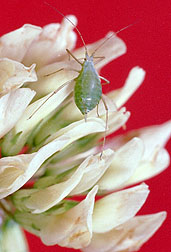This page has been archived and is being provided for reference purposes only. The page is no longer being updated, and therefore, links on the page may be invalid.
|
|
|
|
ARS Scientists, Colleagues Sequence Genome of Major Agricultural Pest
By Dennis O'BrienFebruary 23, 2010
An international group of researchers that includes three Agricultural Research Service (ARS) scientists has sequenced the genome of the pea aphid, an achievement expected to lead to better controls and a deeper understanding of a major agricultural pest. The work was published this week in PLoS Biology by the International Aphid Genomics Consortium, a group that includes researchers from the United States, France, Japan, Spain and Australia.
Aphids spread diseases that cost gardeners and farmers hundreds of millions of dollars each year. Sequencing an aphid genome will help scientists decipher how they reproduce, adapt to new surroundings and develop insecticide resistance, according to Wayne Hunter, a co-author and entomologist with the ARS U.S. Horticultural Research Laboratory in Fort Pierce, Fla. More than 20 aphid species are known to be resistant to current insecticides, and farmers in many areas have been forced to increase insecticide use in recent years.
Other ARS co-authors include Phat Dang, a chemist formerly at the lab in Fort Pierce and now at the ARS National Peanut Research Lab in Dawson, Ga., and Jay Evans, an entomologist at the agency's Bee Research Laboratory in Beltsville, Md. The sequencing was carried out by the Baylor College of Medicine Human Genome Sequencing Center. The information is available online at: http://www.plosbiology.org/article/info:doi/10.1371/journal.pbio.1000313 .
Genome data continues to advance the understanding of insect biology. Genomes from the honey bee, mosquito, fruit fly, silkworm moth and red flour beetle have already been sequenced. Comparing them with the aphid genome may lead to identification of genes that play key roles in how aphids and other insects feed, reproduce, spread diseases and fight off pathogens, according to Evans. The National Human Genome Research Institute designated the sequencing project as a priority in 2005.
The pea aphid Acyrthosiphon pisum is found throughout the United States and Canada. It infests gardens and cultivated fields of peas, sweet peas, sweet clover and alfalfa. Scientists in more than 35 labs worldwide use it to study a wide range of issues. The strain sequenced was collected from alfalfa in Tompkins County, N.Y., and has been used for a number of genetic mapping experiments and for construction of a genomic library. More information, including a list of project contributors, is available at: http://tinyurl.com/ll3jb2.
ARS is the principal intramural scientific research agency of the U.S. Department of Agriculture. The research supports the USDA priority of promoting international food security.

